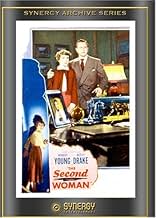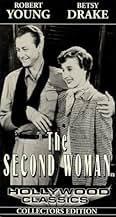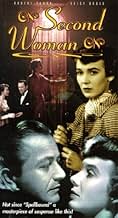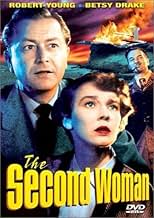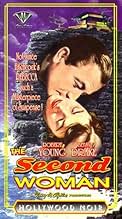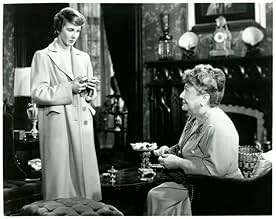CALIFICACIÓN DE IMDb
6.3/10
1.5 k
TU CALIFICACIÓN
Agrega una trama en tu idiomaIn flashback from a 'Rebecca'-style beginning: Ellen Foster, visiting her aunt on the California coast, meets neighbor Jeff Cohalan and his ultramodern clifftop house.In flashback from a 'Rebecca'-style beginning: Ellen Foster, visiting her aunt on the California coast, meets neighbor Jeff Cohalan and his ultramodern clifftop house.In flashback from a 'Rebecca'-style beginning: Ellen Foster, visiting her aunt on the California coast, meets neighbor Jeff Cohalan and his ultramodern clifftop house.
Jason Robards Sr.
- Stacy Rogers
- (as Jason Robards)
Jimmie Dodd
- Mr. Nelson
- (as Jimmy Dodd)
Smoki Whitfield
- Porter
- (escenas eliminadas)
Walter Bacon
- Country Club Guest
- (sin créditos)
Vince Barnett
- Giovanni Strobini
- (sin créditos)
Paul Bradley
- Country Club Guest
- (sin créditos)
- Dirección
- Guionistas
- Todo el elenco y el equipo
- Producción, taquilla y más en IMDbPro
Opiniones destacadas
The Second Woman (AKA: Ellen) is directed by James V. Kern and co- written by Mort Briskin and Robert Smith. It stars Robert Young, Betsy Drake, John Sutton, Florence Bates, Morris Carnovsky and Henry O'Neil. Music is by Joseph Nussbaum and cinematography by Hal Mohr.
Architect Jeff Cohalan (Young) is a troubled man, after the mysterious death of his fiancée in a car crash, he has been acting strangely and lives a lonely life at the Hilltop House he designed for his bride to be. When he meets Ellen Foster (Drake), things perk up as he becomes attracted to her. But he is constantly plagued by bad luck, something which doesn't go unnoticed by Ellen, who suspects that Jeff may not be the victim of paranoia, but of something sinister perpetrated by outside forces
The Coast of Kings.
If you can get away from the looming presence of such great films like Gaslight and Rebecca, then James Kern's movie holds some Gothic noir rewards. The house at the centre of tale is a modern development, which is a shame as it goes against the coastal atmosphere lifting up from the Carmel-On-Sea location that was used for these parts of the film, but otherwise there's a strong brooding mystery bubbling away throughout. As the bizarre instances of misfortune start to mount up on Jeff Cohalan, with director Kern showing a good appreciation of pacing, it builds up a menacing head of steam and then unravels a better than adequate denouement.
Vivian, Vivian, Vivian
Young and Drake inevitably tug at a romantic thread, but they make for an engaging couple and Drake especially gets her teeth into a female role of intelligent substance. John Sutton files in for some decent caddish quotient and Bates and O'Neil add some professionally elder support. Mohr's (Bullets or Ballets/The Lineup) photography is the key, consistently at one with the psychological beats of the plotting, his lighting compositions make the film seem far more higher in production value than it was.
A tale of memory lapses, pet bothering, depression, ugly real estate, dastards and romance, is nicely cloaked by ominous coastal atmospherics and Tchaikovsky! 7/10
Architect Jeff Cohalan (Young) is a troubled man, after the mysterious death of his fiancée in a car crash, he has been acting strangely and lives a lonely life at the Hilltop House he designed for his bride to be. When he meets Ellen Foster (Drake), things perk up as he becomes attracted to her. But he is constantly plagued by bad luck, something which doesn't go unnoticed by Ellen, who suspects that Jeff may not be the victim of paranoia, but of something sinister perpetrated by outside forces
The Coast of Kings.
If you can get away from the looming presence of such great films like Gaslight and Rebecca, then James Kern's movie holds some Gothic noir rewards. The house at the centre of tale is a modern development, which is a shame as it goes against the coastal atmosphere lifting up from the Carmel-On-Sea location that was used for these parts of the film, but otherwise there's a strong brooding mystery bubbling away throughout. As the bizarre instances of misfortune start to mount up on Jeff Cohalan, with director Kern showing a good appreciation of pacing, it builds up a menacing head of steam and then unravels a better than adequate denouement.
Vivian, Vivian, Vivian
Young and Drake inevitably tug at a romantic thread, but they make for an engaging couple and Drake especially gets her teeth into a female role of intelligent substance. John Sutton files in for some decent caddish quotient and Bates and O'Neil add some professionally elder support. Mohr's (Bullets or Ballets/The Lineup) photography is the key, consistently at one with the psychological beats of the plotting, his lighting compositions make the film seem far more higher in production value than it was.
A tale of memory lapses, pet bothering, depression, ugly real estate, dastards and romance, is nicely cloaked by ominous coastal atmospherics and Tchaikovsky! 7/10
This fine "B" film project is basically a psychological film, in the category of the many 1940s and 50s films that were made to explore depth-of-character and motivation. The idea their producers had was to go beyond the inspector calling and assembling suspects in the drawing room to detail who'd done a murder; in the newer mysteries, emphasis was placed upon gradually discovering clues and lines of inquiry, upon revealing actions, pretenses, questionings and complex relationships. This "modern" peeling away of layers of truth relating to an old crime's influence often works brilliantly in my judgment, especially in this movie, Not the least of this unpretentious and beautifully- photographed work's accomplishments is its avoidance of Freudian and false notions that so often muddy attempts to understand individuals' characters in film; Freud applies only to totalitarian societies. Here the investigator is in fact a beautiful woman, very intelligently played as insurance expert and woman-in-love by Betsy Drake. The object of her interest is a man who may or may not be crazy, well-portrayed by Robert Young. He has been suffering a series of accidents or breakdowns that are ruining his life; he has begun to doubt his own sanity. But she insightfully feelss someone is trying to wreck his career and his hopes for happiness. Their search for the perpetrator of the acts being done against him help them to unravel the mystery of his late wife's death and the secrets of the usual nasty small United States town and its equally small-minded citizens (a favorite target of intellectuals in the period, genuinely or not). The director was James V. Kerns, the cinematographer Hal Mohr, whose work was outstanding also. The cast apart from the attractive and bright leads was comprised of Morris Carnovsky, Jean Rogers, Steven Geray, Shirley Ballard, John Sutton and Florence Bates, all well-cast and in top form.. This film was an attempt to do on a low-budget what "Spellbound" had been able to accomplish; the house architect Young designs is outstanding modern architecture; the music by Bernard Nussbaum and the Tschaikovsky excerpts used are I believe add to the atmosphere very nicely. And the relations between characters, acerbic or warm, are unusually well-realized in dialogs and blocking.. This is a true sleeper, with its roots in "The Fountainhead"; and one that deserves much more attention that it has ever received; many elements of an intriguing mystery-noir storyline are quite successfully filmed here indeed.
This interesting psychological drama has a number of strengths that more than make up for the low-budget look and a few minor flaws. The story is full of tension and dramatic possibilities, and things are built up nicely, with the flashback opening and a number of the plot elements frequently reminding you of "Rebecca". It's not really on a par with that story, or with the Hitchcock film version, but it has the same kind of psychology-driven story that takes some skill to tell.
Robert Young plays a talented architect whose life and mental stability have been troubled by a recent tragedy. Young is well cast, since in his earlier years he came across well as this kind of character, who is likable but whose behavior raises a lot of questions. Betsy Drake was an interesting choice for the female lead, emphasizing sincerity, intelligence, and loyalty rather than the glamour and mystery that often characterize noir heroines. Florence Bates also works well as the aunt of Drake's character, though it would have been nice to see the script give her more to work with.
The past and present are tied together in an interesting and unpredictable plot. A more carefully scripted climactic sequence, bringing everything out in a more deliberate manner, would have topped it off even better. But even so, it remains among the better B-movies of its genre, and it makes for an hour and a half of good drama.
Robert Young plays a talented architect whose life and mental stability have been troubled by a recent tragedy. Young is well cast, since in his earlier years he came across well as this kind of character, who is likable but whose behavior raises a lot of questions. Betsy Drake was an interesting choice for the female lead, emphasizing sincerity, intelligence, and loyalty rather than the glamour and mystery that often characterize noir heroines. Florence Bates also works well as the aunt of Drake's character, though it would have been nice to see the script give her more to work with.
The past and present are tied together in an interesting and unpredictable plot. A more carefully scripted climactic sequence, bringing everything out in a more deliberate manner, would have topped it off even better. But even so, it remains among the better B-movies of its genre, and it makes for an hour and a half of good drama.
The Second Woman is a stylish mystery thriller staring second tier leads Robert Young and Betsy Drake and directed by second tier director James V. Kern. But there is nothing second rate about the finished product. This movie is visually and dramatically stimulating from beginning to end.
Young plays an architect brooding over the death of his fiancé in an auto crash in which he was the driver the previous year. After a series of apparent accidents, including a suspicious injury to his horse and a fire at his house, it appears that either someone is out to get him, or he is actually doing destructive things to himself because he is a dangerously off-his-nut paranoiac. The local doctor (Morris Carnovsky) believes the latter. His newly acquired girl friend (Drake), who works in statistical studies for an insurance company, turns detective to prove it is the former. The mystery unfolds at a leisurely pace at first but gradually builds tension with surprising twists and turns of the plot. As with any good thriller, you begin to suspect everyone. A brooding, almost Gothic mood is maintained by Joseph Nussbaum's haunting Tchaikovsky-based score and Hal Mohr's alternately dark and luminous black and white cinematography. Frequent shots of the surf crashing on the lonely rocks of the Central California shore help set the forlorn ambiance. Kern's direction is precise, dialog is intelligent, editing smooth. Young and Drake are charming, and they get expert support from Carnovsky, Henry O'Neil, Florence Bates, and John Sutton.
The Second Woman successfully blends elements of mystery, noir, Gothic, and romantic melodrama. Though released in July 1950, its sensuous style and feel seem to belong more to the l940's than to the 'fifties. But when decades are accounted properly, the year 1950 is actually the last year of the decade we nickname "the forties". In any case it was made near the end of an era. Due to collapse of the studio systems, death and retirement of key personnel, adverse changes in public taste, and other factors, by the end of the 1950's they would no longer be able to make pictures as classy and entertaining as The Second Woman.
Top entertainment from Hollywood's Golden Era.
Young plays an architect brooding over the death of his fiancé in an auto crash in which he was the driver the previous year. After a series of apparent accidents, including a suspicious injury to his horse and a fire at his house, it appears that either someone is out to get him, or he is actually doing destructive things to himself because he is a dangerously off-his-nut paranoiac. The local doctor (Morris Carnovsky) believes the latter. His newly acquired girl friend (Drake), who works in statistical studies for an insurance company, turns detective to prove it is the former. The mystery unfolds at a leisurely pace at first but gradually builds tension with surprising twists and turns of the plot. As with any good thriller, you begin to suspect everyone. A brooding, almost Gothic mood is maintained by Joseph Nussbaum's haunting Tchaikovsky-based score and Hal Mohr's alternately dark and luminous black and white cinematography. Frequent shots of the surf crashing on the lonely rocks of the Central California shore help set the forlorn ambiance. Kern's direction is precise, dialog is intelligent, editing smooth. Young and Drake are charming, and they get expert support from Carnovsky, Henry O'Neil, Florence Bates, and John Sutton.
The Second Woman successfully blends elements of mystery, noir, Gothic, and romantic melodrama. Though released in July 1950, its sensuous style and feel seem to belong more to the l940's than to the 'fifties. But when decades are accounted properly, the year 1950 is actually the last year of the decade we nickname "the forties". In any case it was made near the end of an era. Due to collapse of the studio systems, death and retirement of key personnel, adverse changes in public taste, and other factors, by the end of the 1950's they would no longer be able to make pictures as classy and entertaining as The Second Woman.
Top entertainment from Hollywood's Golden Era.
Intriguing psychological thriller which reflects the forties zeitgeist when psychonanalysis was the craze (see "spellbound" " the dark mirror" "secret beyond the door"...)Because he feels responsible for the death of his fiancée in a car crash ,Jeff is brooding .And he's a victim of strange incidents (he has to shoot his horse whose front leg is broken, his dog is poisoned ) ;"it cannot be a coincidence " says Helen (who plays the role of Ingrid Bergman in "spellbound" although she's not a shrink ) .When the unfortunate man's house is burnt , all coincidence must be ruled out:
Is it a self-inflicted retribution ("he wants to be punished for what he's done) ,as the friendly doctor says , warning Helen and her aunt who accomodates him after the fire against a man who may become dangerous :he destroys everything he likes , and he loves you!
Or is there a criminal mind behind these strange events : hence a whodunit side: is it Ben,the late fiancée's father who treats Jeff like his own son?Keith the philanderer? Or the doctor himself ?
The screenplay sustains suspense throughout and the ending makes sense ; Robert Young as a brooding wistful man down on his luck and Betsy Drake, as headstrong energetic Helen come up to scratch.
Is it a self-inflicted retribution ("he wants to be punished for what he's done) ,as the friendly doctor says , warning Helen and her aunt who accomodates him after the fire against a man who may become dangerous :he destroys everything he likes , and he loves you!
Or is there a criminal mind behind these strange events : hence a whodunit side: is it Ben,the late fiancée's father who treats Jeff like his own son?Keith the philanderer? Or the doctor himself ?
The screenplay sustains suspense throughout and the ending makes sense ; Robert Young as a brooding wistful man down on his luck and Betsy Drake, as headstrong energetic Helen come up to scratch.
¿Sabías que…?
- TriviaAt the beginning of the movie, Robert Young's character tries to commit suicide by running his car engine in an enclosed garage. Then in flashback, the doctor says that he's concerned about Young's character's recurring bouts of depression. In real life, Young suffered from depression for decades, and tried to commit suicide in Westlake Village, CA in January 1991 by running a hose from his exhaust pipe into the interior of his car. Young called a tow truck to try to start his car. The driver noticed the hose, and contacted the police.
- ErroresIn the opening scene, Robert Young's character is discovered suffocated by heavy carbon monoxide in a sealed garage, but nobody else coming in the garage is affected by the deadly gas. Additionally, unless a car is burning oil or running very rich, exhaust fumes are not visible as was shown here. This reveals some type of smoke or vapor was used, not an actual auto exhaust.
- Citas
Jeff Cohalan: Let's see what the tea leaves say about you... there's a trick my grandmother taught me; she learned it from an old witch in Ireland.
Ellen Foster: And so you've been drinking coffee ever since.
- ConexionesReferenced in This Movie Must Die!: The Second Woman (1950) (2021)
Selecciones populares
Inicia sesión para calificar y agrega a la lista de videos para obtener recomendaciones personalizadas
- How long is The Second Woman?Con tecnología de Alexa
Detalles
- Fecha de lanzamiento
- País de origen
- Sitios oficiales
- Idiomas
- También se conoce como
- The Second Woman
- Locaciones de filmación
- Productora
- Ver más créditos de la compañía en IMDbPro
- Tiempo de ejecución
- 1h 31min(91 min)
- Color
- Relación de aspecto
- 1.33 : 1
Contribuir a esta página
Sugiere una edición o agrega el contenido que falta

